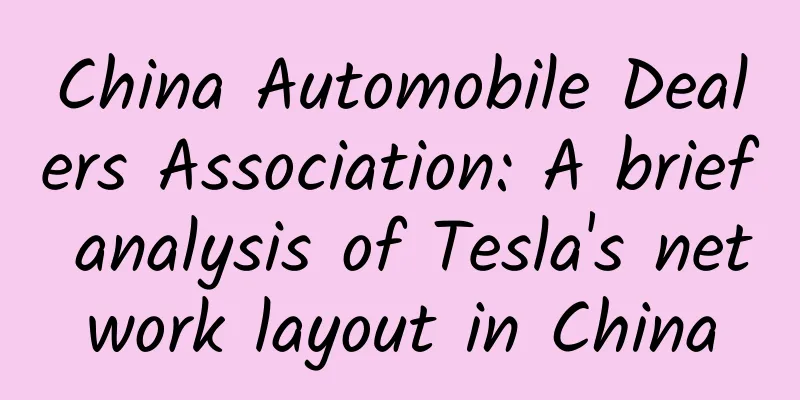China Automobile Dealers Association: A brief analysis of Tesla's network layout in China

|
After Tesla, one of the representatives of new car manufacturers, entered the Chinese market, " direct sales " , " separation of sales and service " , and " supermarket experience stores " became its unique labels, setting off a trend in the field of new energy vehicles. In 2013 , Tesla opened its first sales network in mainland China in Fangcaodi, Beijing; after nearly 10 years of development, with the official start of production of the Shanghai Super Factory in early 2020 , Tesla also accelerated the layout of its sales network and after-sales network in mainland China. As of the first half of this year, Tesla has opened 203 outlets (excluding body repair centers) in the mainland, distributed in 56 cities in 26 provinces (including municipalities) . Compared with December last year , Tesla has entered 8 new cities, with a net increase of 49. So what are the trends in Tesla's network layout changes? What are the rules for the location of outlets? Tesla Network Overview: Experience Centers Still Have a High Proportion Tesla's current channel forms mainly include experience centers, service centers, Tesla centers and body centers. Except for some body centers that are authorized, experience centers, service centers and Tesla centers are all directly operated: experience stores only have sales functions, while Tesla centers are comprehensive outlets with after-sales functions. Tesla now has 98 experience centers, 21 service centers and 84 Tesla centers across the country . Network layout trend: Overall, the coverage of outlets with after-sales functions will be increased, with differences in cities of different levels With the continuous increase in sales and ownership, the importance of after-sales service functions to brand reputation has become more prominent. Tesla's newly built stores have gradually adjusted from experience centers to Tesla centers that integrate experience, delivery, sales and other functions. This can also be seen from the changes in Tesla's network structure in the past six months. The proportion of experience centers has been adjusted from 51% at the end of last year to 48% in the first half of this year , and the proportion of Tesla centers is rising. Of course, Tesla does not adopt the same strategy across the country, but makes targeted adjustments based on sales and ownership structure. From the sales structure, nearly half of Tesla's sales are contributed by first-tier cities, and fourth- and fifth-tier cities contribute less than 5% to sales . Therefore, for first-tier cities where sales are greatly contributed and ownership is constantly increasing, the proportion of Tesla centers that combine sales and after-sales functions is increasing. For third-tier cities with greater potential for new energy development, Tesla has begun to increase its efforts to set up experience centers, aiming to quickly penetrate third-tier cities and increase its sales; the proportion of experience centers in third-tier cities has also increased from 24% at the end of last year to 27% in the first half of this year . From the perspective of site selection: Experience centers are concentrated in commercial business districts, and store locations gradually expand from core business districts to peripheral business districts At present, Tesla's experience centers are still concentrated in commercial districts, relying on commercial centers in urban areas with dense traffic to continuously increase the exposure of brands and products, while using the influence of commercial centers to better present Tesla's high-end, technological, and trendy brand image. Tesla Centers , which cover sales and after-sales functions, are mainly located in traditional automobile business districts. While improving after-sales service capabilities, they take advantage of the concentrated characteristics of consumer groups in automobile business districts (mostly car owners or target car buyers) to further consolidate their sales. When it comes to choosing commercial districts , Tesla generally chooses to settle in the core business district of a city when it enters one. After sales and brand awareness increase, it will gradually expand to the city's peripheral business districts to expand its reach. Take Beijing as an example: Tesla’s first experience center in Beijing was located in Parkview Green, between the East Second and Third Ring Roads, close to the core of Beijing’s CBD ; in the following years, it began to gradually spread to other business districts in the city. The Yitigang Experience Center opened in 2016 and the Chaoyang Joy City Experience Center are basically located near the Fifth Ring Road; with the further increase in sales, the experience centers opened in the past two years have further spread to suburban business districts, such as the Xiangyun Town Experience Center opened in Shunyi District in 2019 and the Xihongmen Huiju Experience Center opened in Daxing District in 2020 . Tesla's direct sales model has always attracted much attention for its channel network layout, and its entry into the market through supermarkets has opened up a whole new situation for the marketing of new energy vehicles. In its early development stage, Tesla's products were priced high, the audience was small, and consumers were not very aware of electric vehicles. Setting up outlets in crowded shopping malls could reach more consumers at close range. At this time, Tesla Experience Centers were more responsible for brand promotion and performance popularization. For start-up car companies, 4S stores are asset-heavy and high-investment, which is difficult to bear, and after-sales service is difficult to support store operations when the number of cars in stock is insufficient. As brand awareness and user stock increase, Tesla appropriately reduces the proportion of experience centers, gradually tilts toward comprehensive stores with 4S -like functions, and selects locations in traditional automobile business districts. On the one hand, store rental costs are reduced, the pace of network expansion is accelerated, covering more cities, and further increasing market share; on the other hand, it can better serve existing customers, and the experience accumulated through the previous authorized after-sales model can also better balance the revenue of electric vehicle after-sales service. It is not difficult to find that Tesla has carefully calculated the layout of its channel network based on a combination of its own phased development goals, funding levels, market environment and other comprehensive factors. It has achieved today's well-defined three-dimensional network structure through careful planning and step-by-step planning. |
<<: Microsoft's business is increasingly moving towards hardware
>>: O2O is ultimately a war between BAT
Recommend
If I accidentally eat the "oil" from a gel pen, is it okay?
Review expert: Gan Qiang, lecturer at Beijing Ins...
Will eating black fungus that has been soaked in the refrigerator for two days cause poisoning? Will keeping leafy vegetables in the refrigerator for 24 hours cause cancer? The truth is →
The refrigerator is one of the greatest invention...
Apple uses Swift and SwiftUI in iOS 15
[[441823]] Preface iOS 15 was released a few mont...
How to plan activities and increase user growth?
Overview: 1. What is operation? 2. Set goals 3. M...
Qingbaijiang, another code of Chengdu to the world
In China's economic landscape, the Beijing-Ti...
When doing promotion, how can we achieve systematic thinking and rhythmic control?
This article will explain from the thinking level...
Satellite image of the China-Laos Railway: How this "mountain and river miracle" was built
On December 3, the China-Laos Railway was fully o...
Like longan? Like small potato? Like kumquat? I bet many people have never seen this noble fruit.
When you think of tropical fruits, which ones com...
The brand extension crisis of Microsoft, Xiaomi and LeTV
[[141229]] Microsoft, the world's largest sof...
30 Thinking Games to Ignite Your Smart Brain Video Course Baidu Netdisk Cloud
30 Thinking Games to Ignite Your Smart Brain Vide...
The new traffic code for Xiaohongshu promotion in 2022
Hot articles are the floodgates that open the tra...
How to become a legendary full-stack engineer
[[134501]] Make a simple app like this: A weather...
How to place advertisements on Zhihu? Give you a promotion secret!
Let me share it with you today! During the delive...
How much does it cost to be an agent of Shangrao children’s clothing mini program? What is the quote for Shangrao children's clothing mini program agent?
How much does it cost to be an agent for a childr...
How much does it cost to develop a homestay mini app in Mudanjiang?
The launch of mini programs has brought convenien...









